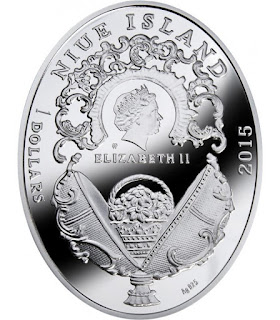Niue 1 Dollar Silver Coin 2015 Gatchina Palace Egg - Faberge Eggs
Series: Imperial Fabergé Eggs
Obverse: At the bottom – open „Spring Flowers Egg” (1899-1903) with a miniature basket and a bouquet of anemones. Above the basket – the effigy of Her Majesty Queen Elizabeth II with an inscription: ELIZABETH II and the mint mark (m/w). Around – a decorative, neo-rococo ornament. Along the rim – the issuer’s name: NIUE ISLAND, the face value: 1 DOLLARS, the hallmark (Ag 925) and the year of issue – 2015.
Reverse: In the foreground you will see an image of Gatchina Palace Egg with 24-carat gold plated elements.
Country: Niue Island.
Year of Issue: 2015.
Metal: Silver.
Silver Fineness: Ag 925/1000.
Content: 0.54 Troy OZ.
Denomination: 1 NZD - legal tender in New Zealand.
Weight: 16.81 g.
Diameter: Ellipse 39 x 29.20 mm.
Quality: Proof.
Mintage: 9,000.
Exterior Decoration: Zircons and Elements in Polished Finish.
Producer: Mint of Poland (Mennica Polska).
Series: Imperial Fabergé Eggs
Trans-Siberian Railway Egg 1900 Faberge Gatchina Palace Egg 1901 Faberge
Gatchina Palace Egg - Faberge Eggs
The Gatchina Palace egg is a jewelled, enameled Easter egg made under the supervision of the Russian jeweler Peter Carl Fabergé in 1901, for Nicholas II of Russia. Nicholas II presented it to his mother, the Dowager Empress Maria Feodorovna, at Easter in 1901. The egg opens to reveal a surprise miniature gold replica of the palace at Gatchina (a town south of St. Petersburg) that was built for Count Grigory Orlov and was later acquired by Tsar Paul I. It is one of two imperial Easter eggs in the collection of the Walters Art Museum in Baltimore, Maryland.
Craftsmanship
The egg was created by Fabergé's workmaster, Mikhail Evlampievich Perkhin (Russian, 1860-1903), and is crafted from gold, enamel, silver-gilt, portrait diamonds, rock crystal, and seed pearls. Detailed work around the palace in the surprise shows cannons, a flag, a statue of Paul I (1754-1801), and elements of the landscape.
The miniature palace is fixed inside the egg and cannot be removed, unlike the 1908 Alexander Palace egg, which Fabergé would create seven years later for Alexandra Fyodorovna. The dimensions are 4 15/16 x 3 9/16 in. (12.5 x 9.1 cm).
Surprise
The egg opens to reveal a miniature gold replica of Gatchina Palace, the Dowager Empress's residence outside Saint Petersburg.
Subsequent ownership
In 1920, the egg was in the possession of Alexander Polovtsov, who was a former employee at the Gatchina Palace and later started an antique shop in Paris. It is not known how Mr. Polovtsov acquired the egg.
In 1930, this egg was sold, along with the 1907 Rose Trellis egg, to American Henry Walters and became a part of the Walters Art Museum Collection in 1931. In 1936, the egg was exhibited with the Rose Trellis egg at the Walters Art Museum in Baltimore, Maryland, and it has been on permanent display since 1952.

